Branch army Disbanded October 1865 | Motto Sic semper tyrannis | |
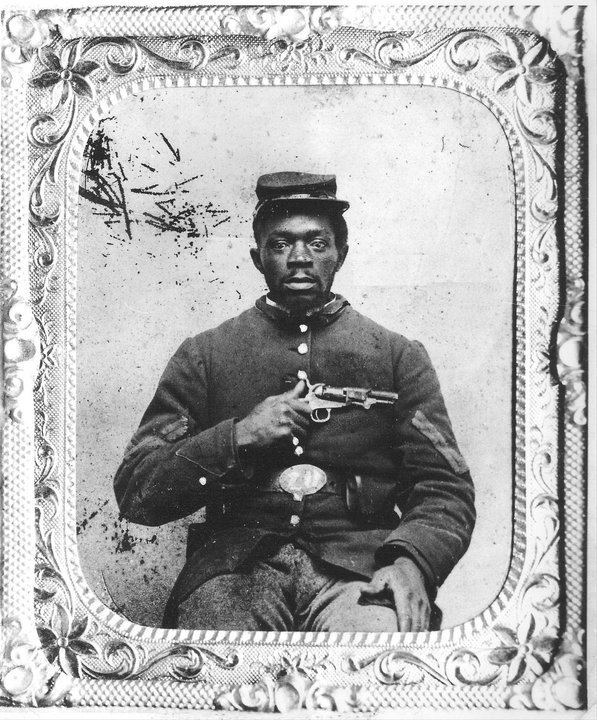 | ||
Active May 22, 1863 – Oct 1865 Size 175 regiments; 178,000 men Similar | ||
United states colored troops african american us army soldiers o give us a flag march
The United States Colored Troops (USCT) were regiments in the United States Army composed primarily of African-American (colored) soldiers. Other people of color who were not of African descent, such as Native Americans Pacific Islanders, and Asian Americans also fought under USCT regiments. They were first recruited during the American Civil War, and by the end of that war in April, 1865, the 175 USCT regiments constituted about one-tenth of the manpower of the Union Army; comprising almost 180,000 men. The USCT was the precursor to the Buffalo Soldier regiments in the American Old West.
Contents
- United states colored troops african american us army soldiers o give us a flag march
- broken bodies suffering spirits part 6 united states colored troops usct
- The Confiscation Act
- Volunteer regiments
- State volunteers
- Corps dAfrique
- Right Wing XVI Corps 1864
- USCT Regiments
- Notable actions
- Prisoners of war
- Numbers of Colored Troops by state North and South
- Postbellum
- Awards
- Legacy
- Tributes
- Other
- Similar units
- References
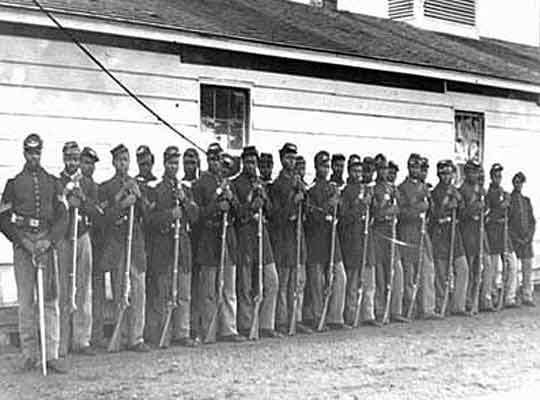
broken bodies suffering spirits part 6 united states colored troops usct
The Confiscation Act
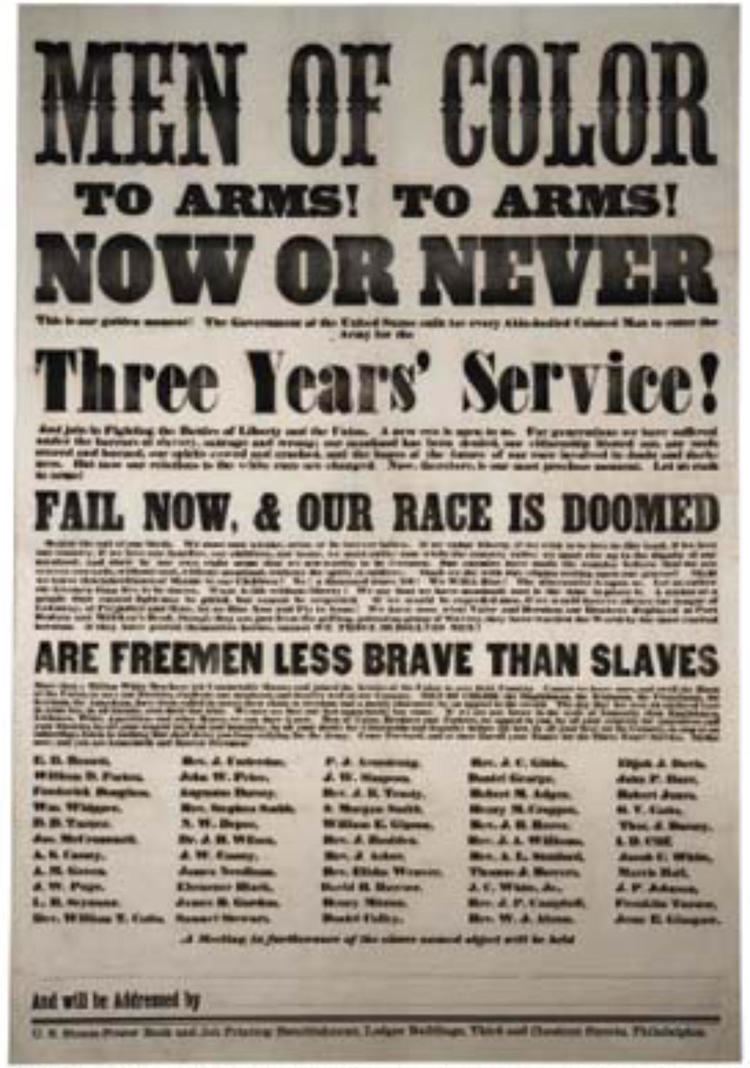
The U.S. Congress passed the Confiscation Act of 1862 in July 1862. It freed slaves whose owners were in rebellion against the United States, and Militia Act of 1862 empowered the President to use freed slaves in any capacity in the army. President Abraham Lincoln was concerned with public opinion in the four border states that remained in the Union, as they had numerous slaveholders, as well as with northern Democrats who supported the war but were less supportive of abolition than many northern Republicans. Lincoln opposed early efforts to recruit black soldiers, although he accepted the Army's using them as paid workers. Native American also played a significant role in the colored regiments of the American Civil War.
In September 1862, Lincoln issued his preliminary Emancipation Proclamation, announcing that all slaves in rebellious states would be free as of January 1. Recruitment of colored regiments began in full force following the Proclamation in January 1863.
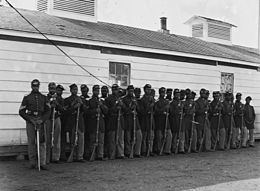
The United States War Department issued General Order Number 143 on May 22, 1863, establishing the Bureau of Colored Troops to facilitate the recruitment of African-American soldiers to fight for the Union Army. Regiments, including infantry, cavalry, engineers, light artillery, and heavy artillery units, were recruited from all states of the Union and became known as the United States Colored Troops (USCT).
Approximately 175 regiments comprising more than 178,000 free blacks and freedmen served during the last two years of the war. Their service bolstered the Union war effort at a critical time. By war's end, the men of the USCT made up nearly one-tenth of all Union troops. The USCT suffered 2,751 combat casualties during the war, and 68,178 losses from all causes. Disease caused the most fatalities for all troops, both black and white.
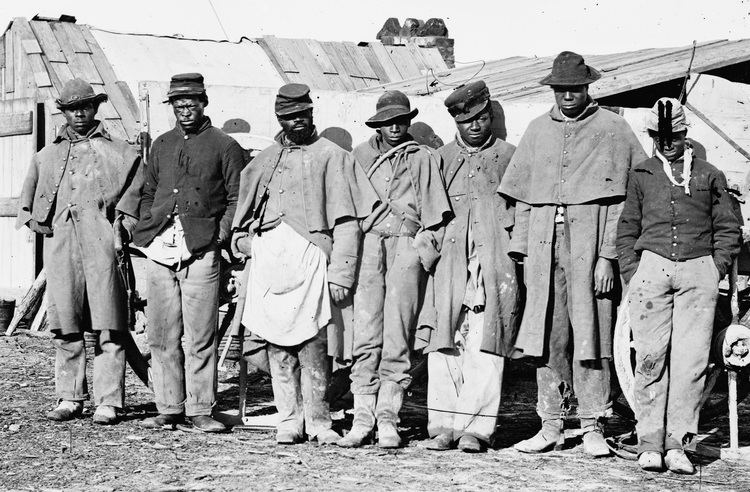
USCT regiments were led by white officers, while rank advancement was limited for black soldiers. The Supervisory Committee for Recruiting Colored Regiments in Philadelphia opened the Free Military Academy for Applicants for the Command of Colored Troops at the end of 1863. For a time, black soldiers received less pay than their white counterparts, but they and their supporters lobbied and eventually gained equal pay. Notable members of USCT regiments included Martin Robinson Delany and the sons of Frederick Douglass.
The courage displayed by colored troops during the Civil War played an important role in African Americans gaining new rights. As the abolitionist Frederick Douglass wrote:
Once let the black man get upon his person the brass letter, U.S., let him get an eagle on his button, and a musket on his shoulder and bullets in his pocket, there is no power on earth that can deny that he has earned the right to citizenship.
Volunteer regiments
Before the USCT was formed, several volunteer regiments were raised from free black men, including freedmen in the South. In 1863 a former slave, William Henry Singleton, helped recruit 1,000 blacks from escaped slaves in New Bern, North Carolina for the First North Carolina Colored Volunteers. He became a sergeant in the 35th USCT. Freedmen from the Roanoke Island Freedmen's Colony, established in 1863 on the island, also formed part of the Free North Carolina Colored Volunteers (FNCCV) and subsequently the 35th. Nearly all of the volunteer regiments were converted into USCT units.
In 1922 Singleton published his memoir (in a slave narrative) of his journey from slavery to freedom and becoming a Union soldier. Glad to participate in reunions, years later at the age of 95, he marched in a Grand Army of the Republic (GAR) event in 1938.
State volunteers
Four regiments were considered Regular units, rather than auxiliaries. Their veteran status allowed them to get valuable federal government jobs after the war, from which African Americans had usually been excluded in earlier years. But, the men received no formal recognition for combat honors and awards until the turn of the 20th century.
These units were:
Corps d'Afrique
The Corps d'Afrique, one of many Louisiana Union Civil War units, was formed in New Orleans after the city was taken and occupied by Union forces. It was formed in part from the Louisiana Native Guards. The Native Guards were former militia units raised in New Orleans, who were property-owning free people of color (gens du couleur libres).
Free mixed-race people had developed as a third class in New Orleans since the colonial years. During the Civil War, many of the free men of color wanted to prove their bravery and loyalty to the Confederacy like other Southern property owners, but the Confederates did not allow them to serve and confiscated the arms of those in the militia. The Confederates believed that enlisting black soldiers would hurt agriculture, as most African Americans were enslaved workers. Since the Louisianan units were composed of freeborn creoles and black freemen, it was clear that the underlying objection was to having black men serve at all.
For later units of the Corps d'Afrique, the Union recruited freedmen from the refugee camps. Liberated from nearby plantations, they and their families had no means to earn a living and no place to go. Local commanders, starved for replacements, started equipping volunteer units with cast-off uniforms and obsolete or captured firearms. The men were treated and paid as auxiliaries, performing guard or picket duties to free up white soldiers for maneuver units. In exchange their families were fed, clothed and housed for free at the Army camps; often schools were set up for them and their children.
Despite class differences between free people of color and freedmen, the troops of the Corps d'Afrique served with distinction, including at the Battle of Port Hudson and throughout the South. Its units included:
Right Wing, XVI Corps (1864)
Colored troops served as laborers in the 16th Army Corps' Quartermaster's Department and Pioneer Corps.
USCT Regiments
Notable actions
The first engagement by African-American soldiers against Confederate forces during the Civil War was at the Battle of Island Mound in Bates County, Missouri on October 28–29, 1862. African Americans, mostly escaped slaves, had been recruited into the 1st Kansas Colored Volunteers. They accompanied white troops to Missouri to break up Confederate guerrilla activities based at Hog Island near Butler, Missouri. Although outnumbered, the African-American soldiers fought valiantly, and the Union forces won the engagement. The conflict was reported by The New York Times and Harper's Weekly. In 2012 the state established the Battle of Island Mound State Historic Site to preserve this area; the eight Union men killed were buried near the battleground.
USCT regiments fought in all theaters of the war, but mainly served as garrison troops in rear areas. The most famous USCT action took place at the Battle of the Crater during the Siege of Petersburg. Regiments of USCT suffered heavy casualties attempting to break through Confederate lines. Other notable engagements include Fort Wagner, one of their first major tests, and the Battle of Nashville.
USCT soldiers were among the first Union forces to enter Richmond, Virginia, after its fall in April 1865. The 41st USCT regiment was among those present at the surrender of the Army of Northern Virginia at Appomattox. Following the war, USCT regiments served among the occupation troops in former Confederate states.
U.S. Army general Ulysses S. Grant praised the competent performance and bearing of the USCT, saying at Vicksburg that:
Prisoners of war
USCT soldiers suffered extra violence at the hands of Confederate soldiers, who singled them out for mistreatment. They were often the victims of battlefield massacres and atrocities at the hands of the Confederates, most notably at Fort Pillow in Tennessee and at the Battle of the Crater. They were at heightened risk for outright murder when captured by Confederate soldiers, as the Confederate army announced its intention to kill black Union soldiers rather than take any prisoner.
The prisoner exchange protocol broke down over the Confederacy's position on black prisoners of war. The Confederacy had passed a law stating that blacks captured in uniform would be tried as rebellious slave insurrectionists in civil courts—a capital offense with automatic sentence of death. In practice, USCT soldiers were often murdered by Confederate troops without being taken to court. The law became a stumbling block for prisoner exchange, as the U.S. government in the Lieber Code objected to such discriminatory mistreatment of prisoners of war on basis of ethnicity. The Republican Party's platform of the 1864 presidential election also condemned the Confederacy's mistreatment of black U.S. soldiers. In response to such mistreatment, U.S. Army general Ulysses S. Grant, in a letter to Confederate officer Richard Taylor, urged the Confederates to treat captured black U.S. soldiers humanely and professionally and not to murder them. He stated the U.S. government's official position, that black U.S. soldiers were sworn military men and not slaves, as the Confederacy asserted they were.
Numbers of Colored Troops by state, North and South
The soldiers are classified by the state where they were enrolled; Northern states often sent agents to enroll ex-slaves from the South. Note that many soldiers from Delaware, D.C., Kentucky, Missouri, and West Virginia were ex-slaves as well. Most of the troops credited to West Virginia, however, were not actually from that state.
Postbellum
The USCT was disbanded in the fall of 1865. In 1867 the Regular Army was set at ten regiments of cavalry and 45 regiments of infantry. The Army was authorized to raise two regiments of black cavalry (the 9th and 10th (Colored) Cavalry) and four regiments of black infantry (the 38th, 39th, 40th, and 41st (Colored) Infantry), who were mostly drawn from USCT veterans. In 1869 the Regular Army was kept at ten regiments of cavalry but cut to 25 regiments of Infantry, reducing the black complement to two regiments (the 24th and 25th (Colored) Infantry).
In the decades that followed, USCT soldiers fought in the Indian Wars in the American West, where they became known as the Buffalo Soldiers. They were nicknamed by Native Americans who compared their hair to the curly fur of bison.
Awards
Soldiers who fought in the Army of the James were eligible for the Butler Medal, commissioned by that army's commander, Maj. Gen. Benjamin Butler. In 1861 at Fort Monroe in Virginia, Butler was the first to declare refugee slaves as contraband and refused to return them to slaveholders. This became a policy throughout the Union Army. It started when a few slaves escaped to Butler's lines in 1861. Their owner, a Confederate colonel, came to Butler under a flag of truce and demanded that they be returned to him under the Fugitive Slave Act of 1850. Butler informed him that since Virginia claimed to have left the Union, the Fugitive Slave Law no longer applied, declaring the slaves to be contraband of war.
Eighteen African-American soldiers won the Medal of Honor, the nation's highest award, for service in the war:
Legacy
The historian Steven Hahn proposes that when slaves organized themselves and worked with the Union Army during the American Civil War, including as some regiments of the USCT, their actions comprised a slave rebellion that dwarfed all others.
The African American Civil War Memorial and Museum helps to preserve pertinent information from the period.
Tributes
Other
The history of the USCT's wartime contribution was kept alive within the U.S. black community by historians such as W. E. B. Du Bois. Since the 1970s and the expansion of historical coverage of minorities, the units and their contributions have been the subject of more books and movies. During the war years, the men had difficulty gaining deserved official recognition for achievement and valor. Often recommendations for decorations were filed away and ignored. Another problem was that the government would mail the award certificate and medal to the recipient, who had to pay the postage due (whether he were white or black). Most former USCT recipients had to return the medals for lack of funds to redeem them.
The motion picture Glory, starring Denzel Washington, Morgan Freeman and Matthew Broderick, portrayed the African-American soldiers of the 54th Massachusetts Volunteer Infantry Regiment. It showed their training and participation in several battles, including the second assault on Fort Wagner on July 18, 1863. Although the 54th was not a USCT regiment, but a state volunteer regiment originally raised from free blacks in Boston, similar to the 1st and 2nd Kansas Colored Infantry, the film portrays the experiences and hardships of African-American troops during the Civil War.
